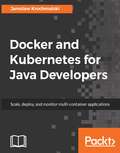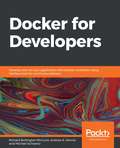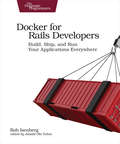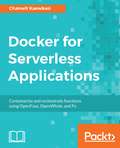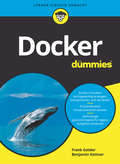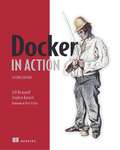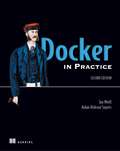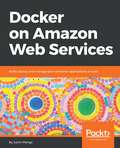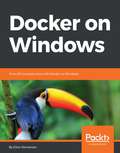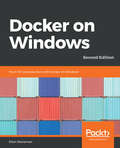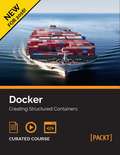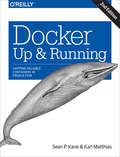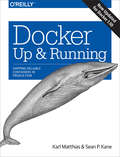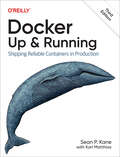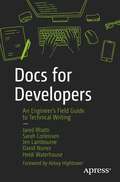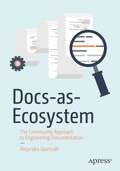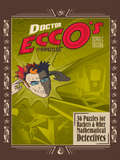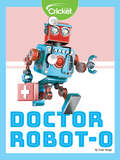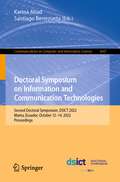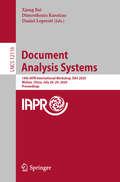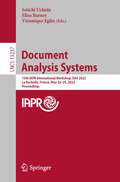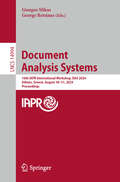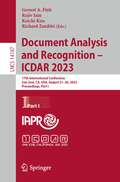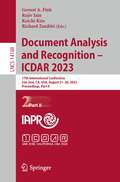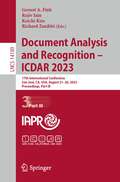- Table View
- List View
Docker and Kubernetes for Java Developers
by Jaroslaw KrochmalskiLeverage the lethal combination of Docker and Kubernetes to automate deployment and management of Java applications About This Book • Master using Docker and Kubernetes to build, deploy and manage Java applications in a jiff • Learn how to create your own Docker image and customize your own cluster using Kubernetes • Empower the journey from development to production using this practical guide. Who This Book Is For The book is aimed at Java developers who are eager to build, deploy, and manage applications very quickly using container technology. They need have no knowledge of Docker and Kubernetes. What You Will Learn • Package Java applications into Docker images • Understand the running of containers locally • Explore development and deployment options with Docker • Integrate Docker into Maven builds • Manage and monitor Java applications running on Kubernetes clusters • Create Continuous Delivery pipelines for Java applications deployed to Kubernetes In Detail Imagine creating and testing Java EE applications on Apache Tomcat Server or Wildfly Application server in minutes along with deploying and managing Java applications swiftly. Sounds too good to be true? But you have a reason to cheer as such scenarios are only possible by leveraging Docker and Kubernetes. This book will start by introducing Docker and delve deep into its networking and persistent storage concepts. You will then proceed to learn how to refactor monolith application into separate services by building an application and then packaging it into Docker containers. Next, you will create an image containing Java Enterprise Application and later run it using Docker. Moving on, the book will focus on Kubernetes and its features and you will learn to deploy a Java application to Kubernetes using Maven and monitor a Java application in production. By the end of the book, you will get hands-on with some more advanced topics to further extend your knowledge about Docker and Kubernetes. Style and approach An easy-to-follow, practical guide that will help Java developers develop, deploy, and manage Java applications efficiently.
Docker for Developers: Develop and run your application with Docker containers using DevOps tools for continuous delivery
by Michael Schwartz Andrew K. Dennis Richard Bullington-McGuireLearn how to deploy and test Linux-based Docker containers with the help of real-world use casesKey FeaturesUnderstand how to make a deployment workflow run smoothly with Docker containersLearn Docker and DevOps concepts such as continuous integration and continuous deployment (CI/CD)Gain insights into using various Docker tools and librariesBook DescriptionDocker is the de facto standard for containerizing apps, and with an increasing number of software projects migrating to containers, it is crucial for engineers and DevOps teams to understand how to build, deploy, and secure Docker environments effectively. Docker for Developers will help you understand Docker containers from scratch while taking you through best practices and showing you how to address security concerns.Starting with an introduction to Docker, you'll learn how to use containers and VirtualBox for development. You'll explore how containers work and develop projects within them after you've explored different ways to deploy and run containers. The book will also show you how to use Docker containers in production in both single-host set-ups and in clusters and deploy them using Jenkins, Kubernetes, and Spinnaker. As you advance, you'll get to grips with monitoring, securing, and scaling Docker using tools such as Prometheus and Grafana. Later, you'll be able to deploy Docker containers to a variety of environments, including the cloud-native Amazon Elastic Kubernetes Service (Amazon EKS), before finally delving into Docker security concepts and best practices.By the end of the Docker book, you'll be able to not only work in a container-driven environment confidently but also use Docker for both new and existing projects.What you will learnGet up to speed with creating containers and understand how they workPackage and deploy your containers to a variety of platformsWork with containers in the cloud and on the Kubernetes platformDeploy and then monitor the health and logs of running containersExplore best practices for working with containers from a security perspectiveBecome familiar with scanning containers and using third-party security tools and librariesWho this book is forIf you're a software engineer new to containerization or a DevOps engineer responsible for deploying Docker containers in the cloud and building DevOps pipelines for container-based projects, you'll find this book useful. This Docker containers book is also a handy reference guide for anyone working with a Docker-based DevOps ecosystem or interested in understanding the security implications and best practices for working in container-driven environments.
Docker for Rails Developers: Build, Ship, and Run Your Applications Everywhere
by Rob IsenbergDocker does for DevOps what Rails did for web development--it gives you a new set of superpowers. Gone are "works on my machine" woes and lengthy setup tasks, replaced instead by a simple, consistent, Docker-based development environment that will have your team up and running in seconds. Gain hands-on, real-world experience with a tool that's rapidly becoming fundamental to software development. Go from zero all the way to production as Docker transforms the massive leap of deploying your app in the cloud into a baby step. Docker makes life as a Ruby and Rails developer easier. It helps build, ship, and run your applications, solving major problems you face every day. It allows you to run applications at scale, adding new resources as needed. Docker provides a reliable, consistent environment that's guaranteed to work the same everywhere. Docker lets you do all things DevOps without needing a PhD in infrastructure and operations. Want to spin up a cluster to run your app? No problem. Scale it up or down at will? You bet. Start by running a Ruby script without having Ruby installed on the local machine. Then Dockerize a Rails application and run it using containers, including creating your own custom Docker images tailored for running Rails apps. Describe your app declaratively using Docker Compose, specifying the software dependencies along with everything needed to run the application. Then set up continuous integration, as well as your deployment pipeline and infrastructure. Along the way, find out the best practices for using Docker in development and production environments. This book gives you a solid foundation on using Docker and fitting it into your development workflow and deployment process. What You Need:All you need is a Windows, Mac OS X or Linux machine to do development on. This book guides you through the process of installing Docker. Some basic familiarity with Linux/Unix is recommended even if you're using a Windows machine.
Docker for Serverless Applications: Containerize and orchestrate functions using OpenFaas, OpenWhisk, and Fn
by Chanwit KaewkasiBuild applications and infrastructures that leverage Function-as-a-Service and DockerKey Features- Implement containerization in Serverless/FaaS environments- Utilize Docker as a functional unit of work for Serverless/FaaS platforms- Use Docker as a portable infrastructure for Serverless ApplicationsBook DescriptionServerless applications have gained a lot of popularity among developers and are currently the buzzwords in the tech market. Docker and serverless are two terms that go hand-in-hand.This book will start by explaining serverless and Function-as-a-Service (FaaS) concepts, and why they are important. Then, it will introduce the concepts of containerization and how Docker fits into the Serverless ideology. It will explore the architectures and components of three major Docker-based FaaS platforms, how to deploy and how to use their CLI. Then, this book will discuss how to set up and operate a production-grade Docker cluster. We will cover all concepts of FaaS frameworks with practical use cases, followed by deploying and orchestrating these serverless systems using Docker. Finally, we will also explore advanced topics and prototypes for FaaS architectures in the last chapter.By the end of this book, you will be in a position to build and deploy your own FaaS platform using Docker.What you will learn Learn what Serverless and FaaS applications are Get acquainted with the architectures of three major serverless systems Explore how Docker technologies can help develop Serverless applications Create and maintain FaaS infrastructures Set up Docker infrastructures to serve as on-premises FaaS infrastructures Define functions for Serverless applications with Docker containersWho this book is forIf you are a Developer, a Docker Engineer, a DevOps Engineer, or any stakeholder interested in learning the use of Docker on Serverless environments then this book is for you.
Docker für Dummies (Für Dummies)
by Frank Geisler Benjamin KettnerHaben Sie Ihre Software schon »containerisiert«? Wissen Sie, wie Sie die Container-Technologie am besten in Ihrem Unternehmen einsetzen können? Wenn nicht, dann sollten Sie jetzt damit beginnen, sich mit dieser Technologie auseinanderzusetzen, da es im Schnitt alle zehn Jahre eine Revolution in der IT gibt. Und nun ist es wieder so weit: Docker erobert die Welt. Dieses Buch stellt die Docker-Technologie vor und präsentiert viele praxisrelevante Beispiele, wie diese Technologie gewinnbringend eingesetzt werden kann. Anschließend wissen Sie, wie Sie Docker für Ihre eigenen Zwecke nutzen können.
Docker in Action
by Jeffrey Nickoloff Stephen KuenzliEven small applications have dozens of components. Large applications may have thousands, which makes them challenging to install, maintain, and remove. Docker bundles all application components into a package called a container that keeps things tidy and helps manage any dependencies on other applications or infrastructure. Docker in Action, Second Edition teaches you the skills and knowledge you need to create, deploy, and manage applications hosted in Docker containers. This bestseller has been fully updated with new examples, best practices, and entirely new chapters. You'll start with a clear explanation of the Docker model and learn how to package applications in containers, including techniques for testing and distributing applications.Purchase of the print book includes a free eBook in PDF, Kindle, and ePub formats from Manning Publications.
Docker in Practice
by Ian Miell Aidan SayersSummaryDocker in Practice, Second Edition presents over 100 practical techniques, hand-picked to help you get the most out of Docker. Following a Problem/Solution/Discussion format, you'll walk through specific examples that you can use immediately, and you'll get expert guidance on techniques that you can apply to a whole range of scenarios.Purchase of the print book includes a free eBook in PDF, Kindle, and ePub formats from Manning Publications.About the TechnologyDocker's simple idea-wrapping an application and its dependencies into a single deployable container-created a buzz in the software industry. Now, containers are essential to enterprise infrastructure, and Docker is the undisputed industry standard. So what do you do after you've mastered the basics? To really streamline your applications and transform your dev process, you need relevant examples and experts who can walk you through them. You need this book. About the BookDocker in Practice, Second Edition teaches you rock-solid, tested Docker techniques, such as replacing VMs, enabling microservices architecture, efficient network modeling, offline productivity, and establishing a container-driven continuous delivery process. Following a cookbook-style problem/solution format, you'll explore real-world use cases and learn how to apply the lessons to your own dev projects.What's insideContinuous integration and deliveryThe Kubernetes orchestration toolStreamlining your cloud workflowDocker in swarm modeEmerging best practices and techniquesAbout the ReaderWritten for developers and engineers using Docker in production.About the AuthorIan Miell and Aidan Hobson Sayers are seasoned infrastructure architects working in the UK. Together, they used Docker to transform DevOps at one of the UK's largest gaming companies.Table of ContentsPART 1 - DOCKER FUNDAMENTALSDiscovering DockerUnderstanding Docker: Inside the engine roomPART 2 - DOCKER AND DEVELOPMENTUsing Docker as a lightweight virtual machineBuilding imagesRunning containersDay-to-day DockerConfiguration management: Getting your house in orderPART 3 - DOCKER AND DEVOPSContinuous integration: Speeding up your development pipeline Continuous delivery: A perfect fit for Docker principlesNetwork simulation: Realistic environment testing without the painPART 4 - ORCHESTRATION FROM A SINGLE MACHINE TO THE CLOUDA primer on container orchestrationThe data center as an OS with DockerDocker platformsPART 5 - DOCKER IN PRODUCTIONDocker and securityPlain sailing: Running Docker in productionDocker in production: Dealing with challenges
Docker on Amazon Web Services: Build, deploy, and manage your container applications at scale
by Justin MengaRun Docker on AWS and build real-world, secure, and scalable container platforms on cloudKey FeaturesConfigure Docker for the ECS environmentIntegrate Docker with different AWS toolsImplement container networking and deployment at scaleBook DescriptionOver the last few years, Docker has been the gold standard for building and distributing container applications. Amazon Web Services (AWS) is a leader in public cloud computing, and was the first to offer a managed container platform in the form of the Elastic Container Service (ECS).Docker on Amazon Web Services starts with the basics of containers, Docker, and AWS, before teaching you how to install Docker on your local machine and establish access to your AWS account. You'll then dig deeper into the ECS, a native container management platform provided by AWS that simplifies management and operation of your Docker clusters and applications for no additional cost. Once you have got to grips with the basics, you'll solve key operational challenges, including secrets management and auto-scaling your infrastructure and applications. You'll explore alternative strategies for deploying and running your Docker applications on AWS, including Fargate and ECS Service Discovery, Elastic Beanstalk, Docker Swarm and Elastic Kubernetes Service (EKS). In addition to this, there will be a strong focus on adopting an Infrastructure as Code (IaC) approach using AWS CloudFormation.By the end of this book, you'll not only understand how to run Docker on AWS, but also be able to build real-world, secure, and scalable container platforms in the cloud.What you will learnBuild, deploy, and operate Docker applications using AWSSolve key operational challenges, such as secrets managementExploit the powerful capabilities and tight integration of other AWS servicesDesign and operate Docker applications running on ECSDeploy Docker applications quickly, consistently, and reliably using IaCManage and operate Docker clusters and applications for no additional costWho this book is forDocker on Amazon Web Services is for you if you want to build, deploy, and operate applications using the power of containers, Docker, and Amazon Web Services. Basic understanding of containers and Amazon Web Services or any other cloud provider will be helpful, although no previous experience of working with these is required.
Docker on Windows
by Elton StonemanLearn how to run new and old Windows applications in Docker containers. About This Book • Package traditional .NET Frameworks apps and new .NET Core apps as Docker images, and run them in containers for increased efficiency, portability, and security • Design and implement distributed applications that run across connected containers, using enterprise-grade open source software from public Docker images • Build a full Continuous Deployment pipeline for a .NET Framework application, and deploy it to a highly-available Docker swarm running in the cloud Who This Book Is For If you want to modernize an old monolithic application without rewriting it, smooth the deployment to production, or move to DevOps or the cloud, then Docker is the enabler for you. This book gives you a solid grounding in Docker so you can confidently approach all of these scenarios. What You Will Learn • Comprehend key Docker concepts: images, containers, registries, and swarms • Run Docker on Windows 10, Windows Server 2016, and in the cloud • Deploy and monitor distributed solutions across multiple Docker containers • Run containers with high availability and fail-over with Docker Swarm • Master security in-depth with the Docker platform, making your apps more secure • Build a Continuous Deployment pipeline by running Jenkins in Docker • Debug applications running in Docker containers using Visual Studio • Plan the adoption of Docker in your own organization In Detail Docker is a platform for running server applications in lightweight units called containers. You can run Docker on Windows Server 2016 and Windows 10, and run your existing apps in containers to get significant improvements in efficiency, security, and portability. This book teaches you all you need to know about Docker on Windows, from 101 to deploying highly-available workloads in production. This book takes you on a Docker journey, starting with the key concepts and simple examples of how to run .NET Framework and .NET Core apps in Windows Docker containers. Then it moves on to more complex examples—using Docker to modernize the architecture and development of traditional ASP.NET and SQL Server apps. The examples show you how to break up monoliths into distributed apps and deploy them to a clustered environment in the cloud, using the exact same artifacts you use to run them locally. To help you move confidently to production, it then explains Docker security, and the management and support options. The book finishes with guidance on getting started with Docker in your own projects, together with some real-world case studies for Docker implementations, from small-scale on-premises apps to very large-scale apps running on Azure. Style and approach Using a step-by-step approach, this book shows you how to use Docker on Windows. It includes practical examples and real-world technical and business scenarios that will help you effectively implement Docker in your environment.There are over 50 examples of Dockerized applications, using C# .NET projects as the source and packaging them into Docker images.
Docker on Windows - Second Edition: From 101 to production with Docker on Windows, 2nd Edition
by Elton StonemanIf you want to modernize an old monolithic application without rewriting it, smooth the deployment to production, or move to DevOps or the cloud, then Docker is the enabler for you. This book gives you a solid grounding in Docker so you can confidently approach all of these scenarios.
Docker: Creating Structured Containers
by Shrikrishna Holla Oskar Hane Neependra Khare Pethuru Raj Jeeva S. Chelladhurai Scott Gallagher Allan Espinosa Rajdeep Dua Santosh Kumar Konduri Vaibhav Kohli Vinod Singh Russ McKendrickBecome an expert in the innovative containerization tool to unlock new opportunities in the way you use and deploy software About This Book • Harness the power of Docker to create a robust and resilient environment in which you can generate portable, composable, scalable, and stable application containers • Learn the art of container networking with elevated efficiency using Docker • Better manage Docker containers using expert techniques and methods • Explore the ways to keep your Docker environment secure • Deploy your applications easily Who This Book Is For Whether you are a developer or a sysadmin, or anything in between, this course will give you the guidance you need to use Docker to build, test, and deploy your applications and make them easier, even enjoyable. What You Will Learn • Learn how to install Docker across all the platforms along with a few troubleshooting techniques • Build, push, and publish images on Docker Hub • Orchestrate multiple containers with Docker Compose • Test and debug applications inside a Docker container • Get to know the basics of networking and see how Docker networking works • Discover the tools built into Docker to gain an insight into your container's performance • Take advantage of the various SaaS offerings from third parties to move monitoring away from your local infrastructure and into the cloud • Familiarize yourself with third-party tools such as Traffic Authorization, Summon, sVirt, and SELinux to secure your Docker environment • Integrate Docker with a wide range of cloud and configuration tools to fully realize its potential In Detail So hot off the presses, the latest buzz that has been on the tip of everyone's tongues and the topic of almost any conversation that includes containers these days is Docker! Docker has been a game-changer when it comes to virtualization. With this course, you will go from just being the person in the office who hears that buzz to the one who is tooting it around every day. This course will be a smooth journey covering Docker from scratch to finish! The first module will help you get familiarized with the fundamentals of Docker. The second module will show you how to create, deploy, and manage a virtual network for connecting containers spanning single or multiple hosts. In the third module, you'll get to grips with monitoring your Docker apps and containers - this will show you how monitoring containers and keeping a keen eye on the working of applications helps improve the overall performance of the applications that run on Docker. The purpose of our fourth module, Securing Docker, is to provide techniques and enhance your skills to secure Docker containers easily and efficiently. Finally, you'll see how to deploy Docker in production and three interesting GUI applications: Shipyard, Panamax, and Tutum. Style and approach Covering best practices to make sure you're confident with the basics, such as building, managing, and storing containers, before diving deeper into Docker security, you'll find everything you need to help you extend and integrate Docker in new and innovative ways.
Docker: Shipping Reliable Containers in Production
by Karl Matthias Sean P. KaneDocker is rapidly changing the way organizations deploy software at scale. However, understanding how Linux containers fit into your workflow—and getting the integration details right—is not a trivial task. With the updated edition of this practical guide, you’ll learn how to use Docker to package your applications with all of their dependencies and then test, ship, scale, and support your containers in production.This edition includes significant updates to the examples and explanations that reflect the substantial changes that have occurred over the past couple of years. Sean Kane and Karl Matthias have added a complete chapter on Docker Compose, deeper coverage of Docker Swarm mode, introductions to both Kubernetes and AWS Fargate, examples on how to optimize your Docker images, and much more.Learn how Docker simplifies dependency management and deployment workflow for your applicationsStart working with Docker images, containers, and command line toolsUse practical techniques to deploy and test Docker containers in productionDebug containers by understanding their composition and internal processesDeploy production containers at scale inside your data center or cloud environmentExplore advanced Docker topics, including deployment tools, networking, orchestration, security, and configuration
Docker: Shipping Reliable Containers in Production
by Karl Matthias Sean P. KaneUpdated to cover Docker version 1.10 Docker is quickly changing the way that organizations are deploying software at scale. But understanding how Linux containers fit into your workflow—and getting the integration details right—are not trivial tasks. With this practical guide, you’ll learn how to use Docker to package your applications with all of their dependencies, and then test, ship, scale, and support your containers in production.Two Lead Site Reliability Engineers at New Relic share much of what they have learned from using Docker in production since shortly after its initial release. Their goal is to help you reap the benefits of this technology while avoiding the many setbacks they experienced.Learn how Docker simplifies dependency management and deployment workflow for your applicationsStart working with Docker images, containers, and command line toolsUse practical techniques to deploy and test Docker-based Linux containers in productionDebug containers by understanding their composition and internal processesDeploy production containers at scale inside your data center or cloud environmentExplore advanced Docker topics, including deployment tools, networking, orchestration, security, and configuration
Docker: Shipping Reliable Containers in Production
by Karl Matthias Sean P. KaneDocker and Linux containers have fundamentally changed the way that organizations develop, deliver, and run software at scale. But understanding why these tools are important and how they can be successfully integrated into your organization's ecosystem can be challenging. This fully updated guide provides developers, operators, architects, and technical managers with a thorough understanding of the Docker tool set and how containers can improve almost every aspect of modern software delivery and management.This edition includes significant updates to the examples and explanations that reflect the substantial changes that have occurred since Docker was first released almost a decade ago. Sean Kane and Karl Matthias have updated the text to reflect best practices and to provide additional coverage of new features like BuildKit, multi-architecture image support, rootless containers, and much more.Learn how Docker and Linux containers integrate with cloud services and KubernetesExperience building OCI images, plus deploying and managing Linux containers with powerful command-line toolsUnderstand how OCI images simplify dependency management and deployment workflow for your applicationsLearn practical techniques for deploying and testing Linux containers in productionDeploy production containers at scale wherever you need themExplore advanced Docker topics, including deployment tools, networking, orchestration, security, and configuration
Docs for Developers: An Engineer’s Field Guide to Technical Writing
by Jared Bhatti Zachary Sarah Corleissen Jen Lambourne David Nunez Heidi WaterhouseLearn to integrate programming with good documentation. This book teaches you the craft of documentation for each step in the software development lifecycle, from understanding your users’ needs to publishing, measuring, and maintaining useful developer documentation.Well-documented projects save time for both developers on the project and users of the software. Projects without adequate documentation suffer from poor developer productivity, project scalability, user adoption, and accessibility. In short: bad documentation kills projects. Docs for Developers demystifies the process of creating great developer documentation, following a team of software developers as they work to launch a new product. At each step along the way, you learn through examples, templates, and principles how to create, measure, and maintain documentation—tools you can adapt to the needs of your own organization. What You'll Learn Create friction logs and perform user research to understand your users’ frustrationsResearch, draft, and write different kinds of documentation, including READMEs, API documentation, tutorials, conceptual content, and release notesPublish and maintain documentation alongside regular code releasesMeasure the success of the content you create through analytics and user feedbackOrganize larger sets of documentation to help users find the right information at the right time Who This Book Is For Ideal for software developers who need to create documentation alongside code, or for technical writers, developer advocates, product managers, and other technical roles that create and contribute to documentation for their products and services.
Docs-as-Ecosystem: The Community Approach to Engineering Documentation
by Alejandra QuetzalliInvesting in engineering documentation (Docs) means investing in community user experience. This book teaches readers how mastering the docs-as-code ecosystem empowers communities to understand better their favorite products and Open-Source (OSS) technologies better. Author Alejandra Quetzalli believes that “docs-as-ecosystem” represents a more comprehensive and collaborative approach to documentation development than “docsas- code” because it recognizes that documentation is more than just code. Docs involve technical writing, design, community feedback, community management, accessibility, SEO, UX, and today… even Artificial Intelligence tools! The word ecosystem promotes a paradigm where we treat documentation as a complex and dynamic system that must be managed and nurtured. In this book, you’ll acquire practical skills such as creating public style guides, incorporating responsive and accessible design, designing user flows and information architecture, retrieving user feedback, and setting up Docs analytics. You’ll learn to identify the difference in work processes between maintaining Docs for a product versus an OSS technology. You’ll discover the secrets to managing technical writers and OSS contributions, all while building a thriving Docs community. To end on a futuristic note, you’ll discover why technical writers who harness Artificial Intelligence (AI) tools (i.e., ChatGPT) need not fear a robot uprising anytime soon. What You'll LearnExamine accessibility and the user experienceUnderstand Information architecture Review docs-as-ecosystem processes Manage technical writersOversee OSS Docs contributions Retrieve and integrate user feedback Build Docs and Education communities Who This Book is ForDevelopers of all levels, VPs of Product/Engineering, Product Managers, and Designers,
Doctor Ecco's Cyberpuzzles: 36 Puzzles for Hackers and Other Mathematical Detectives
by Dennis E. Shasha"Dennis Shasha is the absolute best puzzle writer alive."--David Gelernter, professor of computer science, Yale University In the tradition of Sherlock Holmes, Dr. Ecco is one of the greatest sleuths of our time, a mathematical wizard who uses logic and computer programming to solve crimes, find treasures, and explore space. Join his team, expand the frontiers of your knowledge, and match wits with him on intriguing cases like "The Virus from the Spy" and "The Secrets of Space" and "The Caribou and the Gas." The puzzles collected here require no formal background beyond arithmetic and elementary algebra--just lively curiosity and keen intelligence. With thirty-six illustrated cases organized around eight major mathematical themes (from Combinatorial Geometry and Geography to Ciphers and Secrecy) this book will encourage you to use your mind and your computer in ways you never previously imagined.
Doctor Robot-O
by Lela NargiCan you imagine visiting a doctor's office for an illness or injury, but getting treated by a robot instead? According to some researchers, this could be the reality in the not too distant future. Ongoing research into artificial intelligence and its use in medicine might someday produce robots that will work alongside human doctors and nurses to deliver the best health care possible.
Doctoral Symposium on Information and Communication Technologies: Second Doctoral Symposium, DSICT 2022, Manta, Ecuador, October 12–14, 2022, Proceedings (Communications in Computer and Information Science #1647)
by Santiago Berrezueta Karina AbadThis book constitutes the refereed proceedings of the Second Doctoral Symposium on Information and Communication Technologies, DSICT 2022, held in Manta, Ecuador, in October 2022. The 15 full papers were thoroughly reviewed and selected from the 72 submissions. The papers present research in areas of intelligent systems, artificial intelligence, ICTs and their applications to the real world.
Document Analysis Systems: 14th IAPR International Workshop, DAS 2020, Wuhan, China, July 26–29, 2020, Proceedings (Lecture Notes in Computer Science #12116)
by Xiang Bai Daniel Lopresti Dimosthenis KaratzasThis book constitutes the refereed proceedings of the 14th IAPR International Workshop on Document Analysis Systems, DAS 2020, held in Wuhan, China, in July 2020. The 40 full papers presented in this book were carefully reviewed and selected from 57 submissions. The papers are grouped in the following topical sections: character and text recognition; document image processing; segmentation and layout analysis; word embedding and spotting; text detection; and font design and classification.Due to the Corona pandemic the conference was held as a virtual event .
Document Analysis Systems: 15th IAPR International Workshop, DAS 2022, La Rochelle, France, May 22–25, 2022, Proceedings (Lecture Notes in Computer Science #13237)
by Seiichi Uchida Elisa Barney Véronique EglinThis book constitutes the refereed proceedings of the 15th IAPR International Workshop on Document Analysis Systems, DAS 2022, held in La Rochelle, France, in May 2022.The full papers presented were carefully reviewed and selected from numerous submissions addressing key techniques of document analysis.
Document Analysis Systems: 16th IAPR International Workshop, DAS 2024, Athens, Greece, August 30–31, 2024, Proceedings (Lecture Notes in Computer Science #14994)
by Giorgos Sfikas George RetsinasThis book constitutes the refereed proceedings of the 16th IAPR International Workshop on Document Analysis Systems, DAS 2024, held in Athens, Greece, during August 30-31, 2024. The 27 full papers presented were carefully reviewed and selected from 43 submissions addressing topics like: document analysis and understanding; retrieval and VQA; layout analysis; document classification; OCR correction and NLP; recognition systems; and historical documents.
Document Analysis and Recognition - ICDAR 2023: 17th International Conference, San José, CA, USA, August 21–26, 2023, Proceedings, Part I (Lecture Notes in Computer Science #14187)
by Gernot A. Fink Koichi Kise Rajiv Jain Richard ZanibbiThis six-volume set of LNCS 14187, 14188, 14189, 14190, 14191 and 14192 constitutes the refereed proceedings of the 17th International Conference on Document Analysis and Recognition, ICDAR 2023, held in San José, CA, USA, in August 2023. The 53 full papers were carefully reviewed and selected from 316 submissions, and are presented with 101 poster presentations. The papers are organized into the following topical sections: Graphics Recognition, Frontiers in Handwriting Recognition, Document Analysis and Recognition.
Document Analysis and Recognition - ICDAR 2023: 17th International Conference, San José, CA, USA, August 21–26, 2023, Proceedings, Part II (Lecture Notes in Computer Science #14188)
by Gernot A. Fink Koichi Kise Rajiv Jain Richard ZanibbiThis six-volume set of LNCS 14187, 14188, 14189, 14190, 14191 and 14192 constitutes the refereed proceedings of the 17th International Conference on Document Analysis and Recognition, ICDAR 2021, held in San José, CA, USA, in August 2023. The 53 full papers were carefully reviewed and selected from 316 submissions, and are presented with 101 poster presentations. The papers are organized into the following topical sections: Graphics Recognition, Frontiers in Handwriting Recognition, Document Analysis and Recognition.
Document Analysis and Recognition - ICDAR 2023: 17th International Conference, San José, CA, USA, August 21–26, 2023, Proceedings, Part III (Lecture Notes in Computer Science #14189)
by Gernot A. Fink Koichi Kise Rajiv Jain Richard ZanibbiThis six-volume set of LNCS 14187, 14188, 14189, 14190, 14191 and 14192 constitutes the refereed proceedings of the 17th International Conference on Document Analysis and Recognition, ICDAR 2021, held in San José, CA, USA, in August 2023. The 53 full papers were carefully reviewed and selected from 316 submissions, and are presented with 101 poster presentations. The papers are organized into the following topical sections: Graphics Recognition, Frontiers in Handwriting Recognition, Document Analysis and Recognition.
